July 11, 2013
A boat trip across Skaneateles Lake to search for fossil corals and cool off a little
On the shores of Skaneateles Lake in the Finger Lakes region of Western New York is a spot along the water’s edge where one can find fossil staghorn corals. The spot is well known by geologists but not by too many other people, a good place to find evidence of the sort of life that covered this part of New York when it was under the ocean about 400 million years ago during the Devonian Era. Somehow a big bed of coral got covered up, was preserved, and today the fossil corals literally fall out of the shale cliffs that rise straight up from the water.
The spot, called the Staghorn Cliffs, are accessible only by small boat, and it was a hot, hot Saturday in July. So to deal with the heat and to have an adventure the Wife and I decided to take our personal watercraft to Skaneateles Lake and see if we could locate the cliffs and do some fossil hunting. Weatherwise we absolutely lucked out this rainy year, the sky was partly cloudy and we encountered absolutely no thunderstorms for the entire day.
 An Idealized Version Of Fossil Hunting At Staghorn Point (From Sci-ence)
An Idealized Version Of Fossil Hunting At Staghorn Point (From Sci-ence)
Right now there’s not a lot of information out there about the Staghorn Cliffs, so how did I hear about them? I haven’t been reading any geology textbooks, but I do read a lot of comics. Yes, I’m not ashamed to admit that I search out online comics, buy comic books and the main reason that I subscribe to a daily dead tree newspaper is because every morning I absolutely study the comic page.
From reading this one particular online comic and the narrative that went with it I learned enough about the site to be able to track down the location of the cliffs. But very quickly I realized that this odd bit of information was rare, for instance it took me a good half hour of online search to discover the exact location of the Staghorn Cliffs. I found that all descriptions of the site are quite vague and directions to the site are nonexistent.
In principle this is a good thing, the last thing we need is an endless succession of tourists like us showing up with buckets and carting off all the fossils. So perhaps I should protect the site right here on the blog by perpetuating the vagueness in my description. And perhaps I should have protected the site by not seeking out the site and searching for fossils and bringing them home with me.
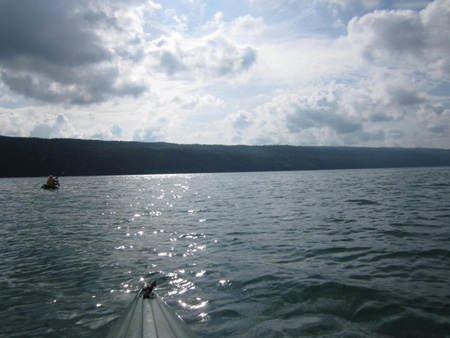 Skaneateles Lake In The Morning
Skaneateles Lake In The Morning
Well, I discovered that the door is closing on uncontrolled access to the site. The cliffs and the land behind it became a protected preserve in 2011, administered by the Finger Lakes Land Trust. So far there is no land access to any part of the preserve, but there are plans to eventually provide public access and create protection of the cliffs from damage and random over-exploitation.
As for my taking of a few fossils, I want everybody to know that we merely collected what fell on the ground. Bits of shale, you see, fall out of the cliffs and collect as gravel at the base of the cliffs. Left alone the shale gravel are pounded by the water, quickly eroding and slowly drifting further out into the lake.
I did not bring excavating equipment and we did not dig into the cliffs. I want everyone to know that. I realize we were very privileged to have this chance to search for these treasures, the least I could do is show some respect.
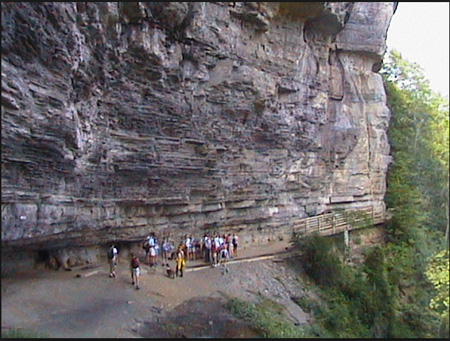 Helderberg Escarpment
Helderberg Escarpment
I worked out this rationalization a while back. About ten years ago we attended a three day wedding at a resort located along the Helderberg Escarpment in western Albany County. As part of the festivities I followed a group of about thirty young, healthy skinny people across the face of the escarpment and later crawled with them on my belly through a cavern. These skinny kids kept calling me the Old Fat Guy and were duly impressed that I was able to keep up with them and didn’t complain.
The big thing I brought away from this wedding expedition is that peer pressure will indeed induce me to do things I normally wouldn’t do. (I also learned caver rule number one is never fart in a cave. You hold it in, or spelunk by yourself.) I still to this day do not understand how I edged along a two foot wide ledge so high up and didn’t one bit fear slipping on the crumbled stone beneath my feet to tumble down the sheer cliff to certain death.
As it turned out, the crumbled stones on that ledge that we were shuffling along were fossilized snail shells that had fallen out of the cliff! Thousands of them! The line of people clinging to the cliff’s edge came to a halt and everyone began to argue. Was it okay to collect the fossil snails, remove them from the site, or does an ecologically minded steward of the land leave such things alone for natural forces to act upon them? We formed two factions, no one was moving off the cliff face until this was settled.
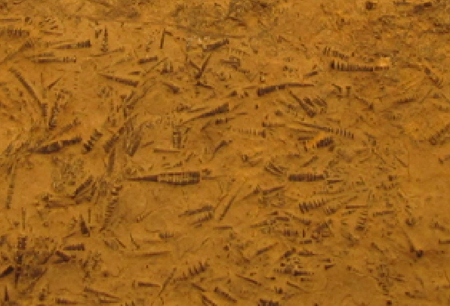 The Wife’s Fossil Snails From The Helderberg Escarpment
The Wife’s Fossil Snails From The Helderberg Escarpment
I decided right there that I was going to bring The Wife (who was back at the resort soaking in the swimming pool) a rock containing fossil snails as a present. So beginning at a point of expediency I vigorously supported the argument that the snails beneath our feet were in the process of falling down the cliff and being destroyed, so to carry a few down the cliff was merely a variation on nature. Besides, someone else pointed out, we were causing much more damage to the fossils and to the cliff itself by shuffling along the ledge, and someone else pointed out that we couldn’t carry off too many snails anyway.
Expediency is a great ideology, it allows you to do just about any damn thing you want. The final point of justification is that in both cases I had to work to collect these fossils. For the Helderberg snail that I grabbed I had to climb up a cliff and step carefully along a high ledge, and for us to find the staghorn coral we had to paddle about forty minutes across a lake and clamber up unto a narrow pile of gravel. We didn’t buy these fossils, they were EARNED.
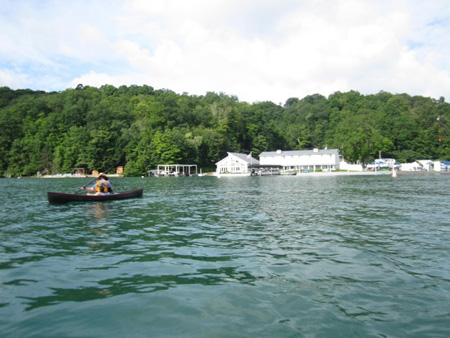 Leaving Sevey’s Boatyard
Leaving Sevey’s Boatyard
Skaneateles Lake is 16 miles long north to south, but only one and a half miles at the widest part. This presented a problem, the State public boat launch is on the north end of the lake at the Village of Skaneateles while the Staghorn Cliffs are near the southern end. No way we were going to paddle round trip some 25 miles or so, this was supposed to be fun.
But four or five miles of paddling round trip we could handle. The Staghorn Cliffs are on the east side of the lake, we found a boatyard located on the west side across and a little ways north. When we called Sevey’s Boatyard the day before they told us no problem if we wanted to leave our car and launch our boats, they asked for a small fee that we could pay “on the honor system.”
So from almost deserted mostly unpopulated lakeside Route 41A I drove the car with boats on top cautiously down a curvy one lane terrific steep grade to the shore. We eventually discovered that much of the shoreline of the lake was choked with fancy mcmansions, almost none of which announced their presence up on the highway. There’s a lot of serious money around there, I guess they want to keep out riffraff like us.
 We Paddled Slowly Past The Cliffs Admiring Them . . .
We Paddled Slowly Past The Cliffs Admiring Them . . .
We managed to launch a little before 9AM, at that time besides us we saw only a few small bass boats on the lake trolling their lines for trout and bullock. Skaneateles is considered the cleanest of the Finger Lakes, supplying drinking water for several municipalities including Syracuse. So I don’t understand why motorized pleasure craft are allowed on the lake, these speedboats and ski-dos always leave a trail of oily foam in their wake that us slow boaters can see all too well.
But whatever, it was too early in the day for the power boats so we had a nice quiet lake to ourselves. The open water was a greenish color which appeared to deepen as the day proceeded. I’ve seen this with other lakes in upstate New York. When the weather is cool the water is so clear you can often see to the bottom, but in warm weather like this algae grows suspended in the liquid, the warmer the weather the greener the water.
The lake is maybe three quarters of a mile wide at that point, after crossing we found the Staghorn Cliffs to be closer than I expected. In fact we paddled slowly past the cliffs admiring them but eventually we realized that we were approaching the southern end of the lake and there were no more cliffs to be seen. That worked as a positive identification, so we confidently paddled back to the cliffs and looked for a place to land the boats.
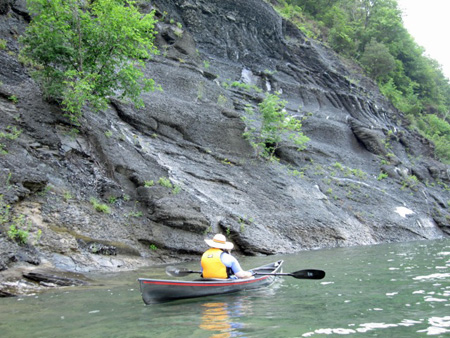 High Water, No Place To Land
High Water, No Place To Land
We prepared for this adventure pretty well but I’d forgotten one thing, the high water. Right now every body of water in upstate New York is filled to capacity and more. Flooding has been rampant everywhere. Driving the night before, I was forced to slow down to 40 mph on the Thruway and almost had to pull over several times because of the torrential thunder storms. There was another big downpour in the evening as we were having dinner at a restaurant.
Because of all the rain everything was soaked. At every part of the lake that we saw, large quantities of water noisily tumbled down cliffs and squeezed out of the rocks. This was very nice to look at, but when we arrived at the cliffs we couldn’t find anyplace to land. The location for our planned activity was mostly underwater. This miscalculation was a big problem, but fortunately was not fatal to our purpose.
In the online comic account that I’d read, the author and his daughter had spent their day walking on a gravel ledge inspecting the stones for fossil coral. At this point I remembered that the account was from 2011, which you may recall was a dry year in this part of the world. Suddenly it looked like we had come all this way for nothing, well, a nice day paddling but we weren’t going to find any fossils.
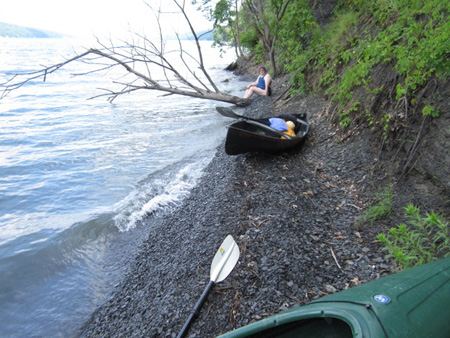
The Wife Found A Gravel Ledge
Then to my amazement I saw that The Wife, who is usually a wimp about such things, had found a pile of gravel above the water about four feet wide and had managed to get her canoe up on it. Turns out she really had to pee, she was already sitting in the water by the time I had managed to pull my kayak up on the pile. This was hardly ideal for fossil hunting but would have to do.
Still, this limited our search area. We could walk in the water no problem as we picked our way along the cliffs. But I quickly realized that it was useless to pull rocks out of the water, the soft shale eroded quickly and any fossils that they may have displayed were gone. So the best place to look was among the freshly fallen stone that was right at the base of the cliffs where we landed.
The Wife, true to form, quickly became bored with this activity. “I thought the fossils would be lying on the ground ready to be picked up!” she complained. She left the searching to me while she hung out admiring the flowers growing out of the cliffs and waded around in the water.
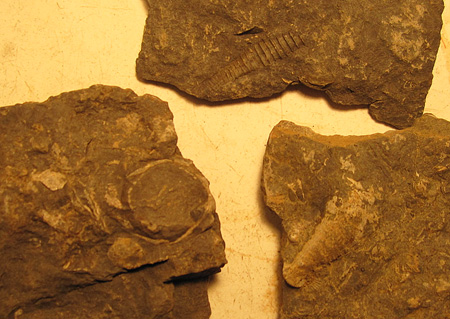
My Not Very Impressive Staghorn Coral Finds
The teal deer version of this story is yes, I found exactly one small mostly complete staghorn coral fossil and several bigger cross section staghorns and some impressions. I also found some very nice brachiopods, which back in the Devonian were underwater animals that looked like plants rooted in the ground, similar to present day sea lilies. I was hoping for more interesting finds but hey, under the circumstances we did pretty good.
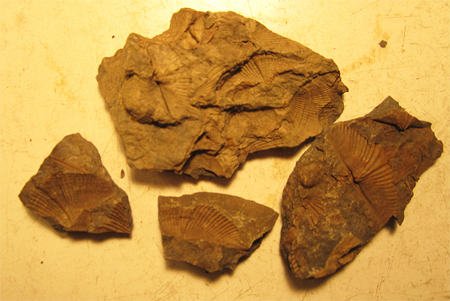
A Few Nice Brachiopods
The best hunting spot I found was right next to my kayak, this is where I found the small staghorn. The trick, I discovered, was to find a large shard of shale the size of my hand and encourage it to split along the already existing fractures by applying a little pressure with my fingers. I know, I’m walking the ethical line here that I drew for myself, but I didn’t pull anything from the cliff and I didn’t break any rocks that weren’t already on the verge of breaking.
The base of the cliff is composed of solid slabs of shale, but above the base and as high up as we could see the cliff is composed of small shards of shale pressed together. On one part of the cliff these shards are glued together with very soft sedimentary rock that I could see was melting from all the wet. In other sections of the cliff the bits of shale are crushed together cleanly in a mass.
I’m guessing this was originally a 400 million year old gravel pit that got buried and got crushed along with whatever else had fallen into the pit. The cliff was very porous, water oozed out of the crushed stones to drip down the cliff face. At about the middle of the cliffs was a spectacular waterfall that almost looked artificial, like in somebody’s garden.
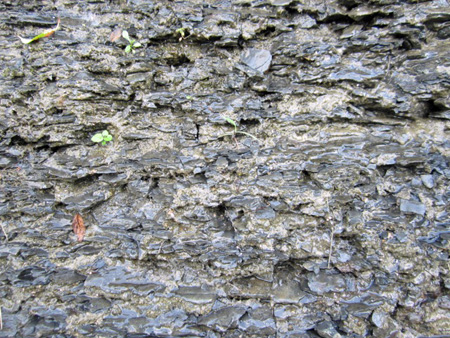
Shale Gravel Glued With Sedimentary Rock Dripping Water
Like I mentioned, the lakeshore is lined with fancy expensive mcmansions. Almost every accessible spot, no matter how steep, had been turned into private property and developed. On either side of the cliffs north and south the endless string of summer “homes” began again, I don’t recall seeing any large empty lots except right here at the cliffs.
I’m guessing that the Staghorn cliffs had not been developed because they were considered too unstable to build on. But considering all the valuable upscale real estate along the shore, you know it was a matter of time before someone tried to build on the cliffs. So it is a good thing that the Staghorn Cliffs along with the land behind them has become a dedicated preserve protected from the encroaching rich people.
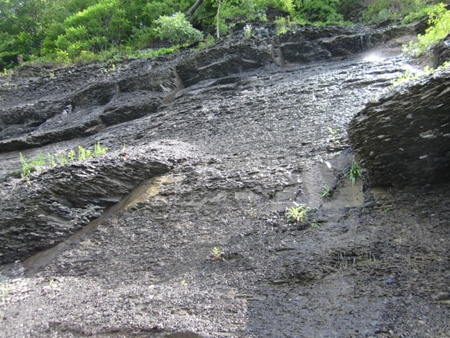
Staghorn Cliffs
In the early afternoon the weather held up pretty good and the damn speedboats came out. Personally I don’t understand the appeal of zipping back forth in a motorized boat with no destination in mind, making noise churning the water and leaving a trail of oil. It’s like driving a car, I mean, don’t people do enough of that.
Paddling a boat is to a speedboat what being a pedestrian is to an auto. Speeding down the road in a car the passengers completely miss everything along the road that isn’t big or identified with brief signage. In addition the drivers of cars can’t see anything but the road, their minds are occupied with steering the car and the unoccupied parts of their brains are too small to appreciate anything anyway.
The same with speedboats, you miss all the interesting things and your range of travel is limited to open water. For example you can’t get too close to the Staghorn cliffs in a speedboat, the gravel would tear up the hull and mangle the propeller. Driving a speedboat you miss seeing the lake, the only thing you experience is the speedboat itself. I guess that’s the idea.
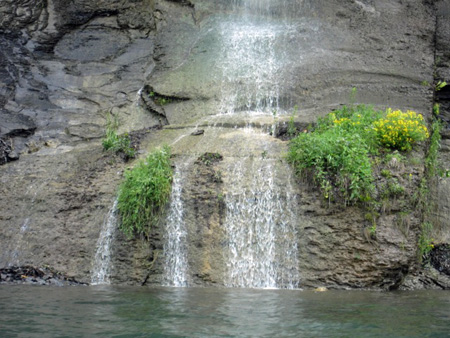
Waterfall, Staghorn Cliffs
Well, the best time to use our paddle boats is the morning when we have the lake to ourselves, and now it was well into afternoon. We pulled our boats off the gravel ledge and paddled back to the boatyard, battling the waves of the speedboats tearing past us. Don’t get me wrong, the return trip was quite pleasant. But it was clearly time to return with our little bag of fossils and call it a day.